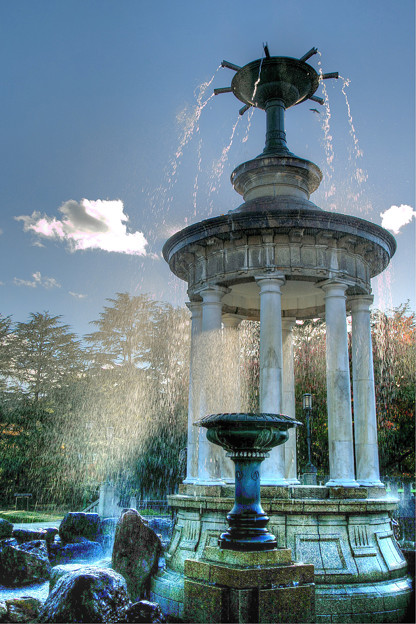This Fountain Tower was built in time for the 10th Kansai Area Prefectural Union Joint Exhibition of 1910 at Tsuruma Park in Nagoya.
It has a combination of Western and Eastern styles. That is very remarkable when we see the Roman-style marble pillars
for the tower and the Japanese-style rock structure in the ponds.
The tower is 10.2m high and the diameter of the top flat circular board is 2.5m. The paving stones were recycled from demolished street car railway
track beds from downtown Nagoya. The floor of the upper platform is
covered with marble stones. What’s more, a type of famous Japanese
ceramics called Bizen ware is used for decorative handrails or
banisters. Most of the stones in the ponds were from Kiso River, a prominent river for people in this region for centuries.
When we look at those eight narrow water spouts sticking out from the top flat circular board,
you will see the water from each spout hits the board
below and trickles down into the ponds. That eventually generates
splashes and mists of water. It was, indeed, well designed and
delighted the visitors. So it became a symbol of Tsuruma Park.
The designer was Mr. Teiji Suzuki, an engineer and professor, known as
the "father of modern architecture in Nagoya." He designed more than 40
buildings including private residences in and around the city of
Nagoya. Those buildings were pretty much modern with a beautiful
balance of western and eastern tastes and drew people's attention.
Unfortunately, only 23 remain today and the rest of the buildings were
demolished or destroyed mostly by bombing during the second world war.
It was just fortunate that the fountain tower was safe.
Interestingly, in 1973 the fountain tower at Tsuruma Park was once removed from this spot due to a new subway construction. The new subway line was planned to run just under the fountain.
With 60 years passing by since its construction, the city was afraid
that building the subway might cause damage to the old fountain tower. 4 years later it was restored again exactly as it was before.
The fountain tower was designated as a municipal cultural property in 1986 and will continue to be a symbol of the park.
(images are from the web)




